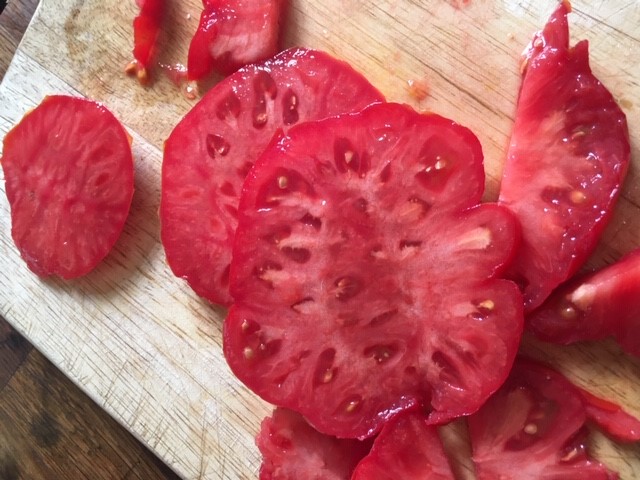
The beefsteak tomatoes have started ripening in the greenhouse, the most delicious crop of the year. I could survive all of late summer just on beefsteak tomatoes, a bit of salt and olive oil, and hunks of bread to mop up the juices, and by the way the greenhouse is looking now I most probably will. The first one was sliced up and drizzled in oil with a sprinkling of salt and a scattering of torn basil leaves, and so was the second, and the third. Honestly I can’t see myself getting bored with this any time soon. It is one of the great treats of the vegetable garden year.
I am growing beefsteaks almost exclusively this year. I do like having a variety of tomatoes but with space tight I decided to just concentrate on my favourites for this one year. I’ve also got fed up of cherry tomatoes. I love them tomatoes for early ripening and for popping into children’s mouths like healthy sweeties, but for the past couple of years I have found them splitting constantly if not watered with absolute regularity. Beefsteaks take a lot longer to mature and ripen simply because they are so much bigger, but their flavour is wonderful, lunch under a dappled terrace on market day in Provence. If I can replicate that in my greenhouse then I think I’m making pretty good use of it.
Anyway, ripening time is here. First across the finish line is a variety called ‘Buffalo Steak’. This is not the most romantic of variety names but when you slice the tomato across the middle you can instantly see how it was called this: it is dense and juicy and deep red. I bought two plants of this variety from Simpsons Seeds back in April, and they arrived quickly – big brutes of plants – and quickly shot away, dwarfing all of the seedlings I had grown myself. I can highly recommend them for next year if you want to get some tomato plants off to a really early start. Other beefsteak varieties coming along behind them are ‘Marmande’, ‘Mucho Miele’ and ‘Bushsteak’.

The trick to getting them to ripening has been a combination of this early start and basic good tomato maintenance. They are tied up on really sturdy supports and in large pots filled with a combination of garden compost and bought compost, plus water retaining crystals. Every pot is sitting in its own tray so that it can be kept good and moist easily and so that the compost never dries out. Tomatoes are such thirsty plants that they really need a huge amount of watering once they get big and so anything that you can put in place to make that easier is hugely helpful. Once a week they are given an organic seaweed feed (likewise they are hugely greedy). This year for the first time we have also started adding a scattering of dolomitic limestone to the soil every few weeks. This raises the pH of the soil, which in turn makes nutrients more available to the plants, and it is one of the things recommended to try to avoid blossom end rot, which our tomatoes have often suffered from and which is caused by a magnesium deficiency. Not this year, so I recommend it as an easy way around this.
The greenhouse is really starting to hit its stride now and there will be more crops coming along very soon: the first of the aubergines, the peppers and chillies, and a good few melons, but it’s wonderful to hit the first crop of this next part of my gardening year.


